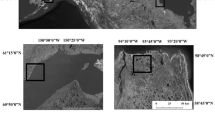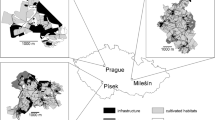Abstract
This work reports the first results of a 3-year study (1998–2001) on habitat use and preferences by wild lesser rheas (Rhea pennata pennata) in the ecotone Monte–Patagonian steppe of Argentina. Ponds and four different habitat alternatives for lesser rheas were determined using satellite images and different structural vegetation characteristics: steppe, shrubland, shrub steppe, and mallines. Lesser rheas (adults, juveniles and chicks) used all habitats available to feed, although they showed preference for mallines, open areas that offer good visibility and abundant food resource. Rheas used shrub steppe and steppe for nesting, but they did not show preference for either habitat type. Nest site had a higher percentage of vegetation cover than control sites. Lesser rheas apparently preferred concealed sites for nesting since they offer protection from severe climate conditions and from predators. Our results suggest that habitat preference by lesser rheas counterbalances profitability of feeding to the corresponding cost of predation.
Similar content being viewed by others
References
Anderson S.H. and Gutzwiller K.L. (1996). Habitat Evaluation Methods. Research and Management Techniques for Wildlife and Habitats. Wildlife Society, Bethesda, Maryland, 592–606
Bank M.S., Lawrence R.K., Franklin W.L. and Ortega I.M. (1999). The importance of wetland habitats to people and wildlife in the grazing agroecosystem of Southern Chile. Vida Silvestre Neotropical 7(1): 43–45
Bank M.S., Sarno R.J. and Franklin W.L. (2003). Spatial distribution of guanaco mating sites in southern Chile: conservation implications. Biological Conservation 112: 427–434
Bellis L.M. 2004. Selección de hábitat y productividad en ñandúes. PhD Thesis, Facultad de Ciencias Exactas Físicas y Naturales, Universidad Nacional de Córdoba, Argentina.
Bellis L.M., Martella M.B. and Navarro J.L. (2004a). Habitat use by wild and captive-reared greater rheas in agricultural landscapes. Oryx 38(3): 304–310
Bellis L.M., Martella M.B., Navarro J.L. and Vignolo P.E. (2004b). Home range of greater and lesser rhea in Argentina: relevance to conservation. Biodiversity and Conservation 13(14): 2589–2598
Block W.M. and Brennan L.A. (1993). The habitat concept in ornithology. In: Power, D.M. (eds) En Current Ornithology, pp 35–91. Plenum Press, New York
Bowman G.B. and Harris L.D. (1980). Effect of spatial heterogeneity on ground-nest predation. Journal of Wildlife Management 44: 806–813
Bruning D.F. (1974). Social structure and reproductive behavior in the Greater Rhea. The Livings birds 13: 251–294
Chebez J.C. (1994). Los que se van. Especies argentinas en peligro. Editorial Albatros, Buenos Aires, Argentina
Codenotti T.L. and Alvarez F. (2000). Habitat use by greater rheas in an agricultural area of Southern Brazil. Revista de Etologia 2(2): 77–84
Craig J.L. (1994). Meta-populations: is management as flexible as nature?. In: (eds) Creative Conservation, pp 50–63. Chapman and Hall, London, UK
Del Hoyo J., Elliot A. and Sargatal J. (1992). Handbook of the Birds of the World. Lynx Editions, Barcelona
Eastman J.R. (1997). IDRISI for Windows. Tutorial Exercises v 2.0. J. Ronald Eastman. Clark University, Worcester, MA USA
Fernández G. and Reboreda J.C. (2002). Nest-site selection by male Greater Rheas. Journal of Field Ornithology 73(2): 166–173
Golluscio R.A., Deregibus V.A. and Paruelo J.M. (1998). Sustainability and range management in the Patagonian steppes. Ecología Austral 8: 265–284
Hooge P.H., Stanback M.T. and Koening W.D. (1999). Nest site selection in the acorn woodpecker. The Auk 116(1): 45–54
Hoover J.P. and Brittingham M.C. (1998). Nest site selection and nesting success of wood thrushes. Wilson Bulletin 110(3): 375–383
(2004). IUCN Red List of Threatened Species. IUCN, Gland, Switzerland
Jones J. (2001). Habitat selection in avian ecology: a critical review. The Auk 118(2): 557–562
León R., Bran D., Collantes M., Paruelo J.M. and Soriano A. (1998). Grandes unidades de vegetación de la Patagonia extra andina. Ecología Austral 8: 125–144
Lloyd P., Plaganyi E., Lepage D., Little R.M. and Crowe T.M. (2000). Nest-site selection, egg pigmentation and clutch predation in the ground-nesting Namaqua Sandgrouse. Ibis 142: 123–131
Lombardi C.M. (1994). Feeding and Vigilance in wild Greater Rhea harems. Bird Behavior 10: 29–35
Manero A. 1999. Uso de Hábitat del cauquén común (Chlöephaga picta) en Santa Cruz. I mplicancias para su Manejo. M.S. Thesis, Centro de Zoología Aplicada, Universidad Nacional de Córdoba, Argentina.
Martella M.B., Renison D. and Navarro J.L. (1995). Vigilance in the greater rheas: effects of vegetation height and group size. Journal Field Ornithology 66(2): 215–220
Martin T.E. and Roper J.J. (1988). Nest predation and nest-site selection of a western population of the hermit thrush. The Condor 90: 51–57
Matthiopoulos J. (2003). The use of space by animals as a function of accessibility and preference. Ecological Modelling 159: 239–268
Milton S., Dean W.R.J and Siegfried W.R. (1994). Food selection by ostrich in Southern Africa. Journal of Wildlife Management 58(2): 234–248
Morrison M.L., Marcot B.G., Mannan R.W. 1992. Wildlife-Habitat Relationships. Univ.of Winsconsin Press.
Navarro J.L. and Martella M.B. (2002). Reproductivity and reasing of greater rhea and lesser rhea. A review. Archiv für Geflügel Kunde 66(1): 1–9
Neu C.W., Byes C.R. and Peek J.M. (1974). A technique for analysis of utilization-availability data. Journal of Wildlife Management 38(3): 541–545
Novaro A., Funes M. and Walker R.S. (2000). Ecological extintion of native prey of a carnivore assemblage in Argentine Patagonia. Biological Conservation 92: 25–33
Paruelo J.M., Jobbagy E.G. and Sala O.E. (1998). Biozones of Patagonia (Argentina). Ecología Austral 8: 145–153
Pople A., Cairns S.C. and Grigg G.C. (1991). Distribution and Abundance of emus, Dromaius novaehollandiaein relation to the environment in the South Australian pastoral zone. Emu 91: 222–229
Reboreda J.C. and Fernández G. (1997). Sexual, seasonal and group size differences in the allocation of time between vigilance and feeding in the Greater Rhea (Rhea americana). Ethology 103: 198–207
Sánchez-Lafuente A.M., Alcantara J.M. and Romero M. (1998). Nest-site selection and nest predation in the purple swamphen. Journal of Field Ornithology 69(4): 563–576
Sarasqueta D.V. (1995). Incubación y cría de choiques. Comunicación Técnica N° 88. INTA, EEA Bariloche
Somlo R. (1997). Atlas dietario de los herbívoros patagónicos. Prodesar, INTA, GTZ, Bariloche, Argentina
Thogmartin W.E. (1999). Landscape attributes and nest-site selection in wild turkeys. The Auk 116(4): 912–923
Verlinden A. and Masogo R. (1997). Satellite remote sensing habitat suitability for ungulates and ostrich in the Kalahari of Botswana. Journal of Arid Environments 35: 563–574
Webb D.R. (1987). Thermal Tolerance of Avian Embryos: a review. The Condor 89: 874–898
White G.C. and Garrot R.A. (1990). Analysis of Wildlife Radio-Tracking Data. Academic Press, Inc., San Diego, California
Williams J., Siegfreid W, Milton S., Adams N., Dean W., Du Plessis M. and Jackson S. (1993). Field metabolismwater requirements, and foraging behavior of wild ostriches in the Namib. Ecology 74(2): 390–404
Zar J.H. (1984). Biostatistical Analysis. Prentice-Hall, Inc., Englenhood Cliffs, New Jersey
Author information
Authors and Affiliations
Corresponding author
Rights and permissions
About this article
Cite this article
Bellis, L.M., Navarro, J.L., Vignolo, P.E. et al. Habitat preferences of lesser rheas in Argentine Patagonia. Biodivers Conserv 15, 3065–3075 (2006). https://doi.org/10.1007/s10531-005-5398-5
Received:
Accepted:
Published:
Issue Date:
DOI: https://doi.org/10.1007/s10531-005-5398-5




